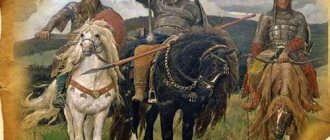Ryazan prince
Georgy Yudin. Dobrynya Nikitich's campaign against the fierce serpent. Illustration for the epic. Year unknown
Andrey Ryabushkin Dobrynya Nikitich. Illustration for the book “Russian epic heroes”. 1895
Georgy Yudin. Dobrynya Nikitich and the Tatar hero-fighter. Illustration for the epic. Year unknown
According to epics, Dobrynya was born in Ryazan at a time when Ryazan was “reputed as a village.” Many researchers believe that this hero was of a princely family. His father Nikita Romanovich was a “prince without an inheritance”; he died at the age of 60, leaving a young wife and an infant son. Mother Amelfa Timofeevna gave Dobrynya a good education. In the sciences, he kept up faster than his peers; at the age of 12 (in some versions - 15) years, he mastered the wisdom of war. Vladimir Propp wrote:
Rostovsky Popovich
Georgy Yudin. Alyosha Popovich and Tugarin. Illustration for the epic. Year unknown
Boris Olshansky. Alyosha Popovich and Elena Krasa. 1996. Museum of Slavic Painting
Andrey Ryabushkin. Alesha Popovich. Illustration for the book “Russian epic heroes”. 1895
Alyosha Popovich was portrayed as the youngest of the heroes. The epics said that he was the son of a cathedral priest from Rostov (now a city in the Yaroslavl region). In different texts, two Rostov saints were called Alyosha's father - St. Leonty, whose relics are in the Rostov Assumption Cathedral, or Theodore, the first bishop of Rostov.
Despite his religious upbringing, Alyosha grew up as a joker and joker, and his courage always bordered on insolence. In some epics he was portrayed as a “woman’s mockingbird,” and in later texts he became a completely negative character. For example, it was sometimes told how Alyosha lied about Dobrynya’s death and deceived him into trying to marry his wife Nastasya. Dobrynya found out about this in time and managed to stop the wedding at the last moment. In the 20th century, research proved that initially Alyosha was not opposed to other heroes, but was the embodiment of truly popular qualities - passion, ingenuity and humor.
In the epic “Alyosha Popovich and Tugarin Zmeevich” the hero saw an enemy at the princely feast - Tugarin. Prince Vladimir the Red Sun greeted him as a dear guest, and Princess Eupraxia, in front of her husband, showed Tugarin unambiguous signs of attention. Alyosha began to mock this behavior, asking for a fight, and defeated Tugarin by cunning. Different versions describe how Popovich pretended to be hard of hearing so that Tugarin would get closer, or tricked his opponent into turning away, or struck while hiding behind the horse's mane. Alyosha jokingly offered Tugarin’s head to the prince as a dish:
You are here, Vladimir Stolnokievskaya! If you don’t have a beer cauldron now, - But those Tugarin’s violent heads; If the guys don’t have big bowls of beer, then those Tugarin’s are clear; If you don’t have big saucers, then those Tugarinovs will have big ears.
It is believed that the image of the hero Alyosha goes back to the real Rostov warrior Alexander Popovich, who died in 1223 in a battle with the Mongol-Tatars on the Kalka River. Academician Dmitry Likhachev attributed the first mention of Alexander Popovich in the chronicle to 1423, that is, 200 years after the hero’s supposed death. Likhachev established that it was not the hero who ended up in the epics from the chronicle, but, on the contrary, the chronicle recorded the character from the epic as a historical person. This was a conscious step of the chroniclers in the era of the formation of a centralized Russian state.
Folklorist Vladimir Propp believed that the image of Alyosha Popovich could have appeared soon after the baptism of Rus', because at that time the clergy were not yet perceived as a privileged class far from the common people. In a later era, the son of a priest could not have become in the eyes of the people a daring daredevil, mocking those in power, and remembering even his own priest father in jokes.
The same period - the 11th century - is indirectly indicated by the name of Alyosha’s rival, Tugarin Zmeevich. At that time, the Polovtsian Khan Tugarkan fought with Russia, and his daughter became the wife of the Kyiv prince Svyatopolk Izyaslavich. In the 11th–12th centuries, princes often entered into agreements with the Polovtsians and acted with them against other Russian principalities. The people condemned friendship with the enemy for the sake of fratricidal wars, and it was precisely this “friendship” that Alyosha put an end to by killing Tugarin.








